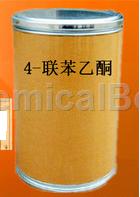Background and overview[1][2]
Biphenyl acetophenone is an intermediate for the synthesis of biphenylacetic acid. Biphenylacetic acid is a good non-steroidal anti-inflammatory drug and an effective metabolite of ibuprofen. It was first marketed in Japan in 1986 and is a clinical Basic symptomatic drugs used in the treatment of rheumatic diseases. The current general synthesis method of benzophenone has the disadvantages of difficult to obtain raw materials, high toxicity, complex operation, and low yield.
Biphenylphenone (Ⅰ) is one of the important intermediates in the synthesis of biphenylacetic acid. Its purity directly affects the purity of biphenylacetic acid. Its impurities will eventually be brought into the product and are difficult to remove. Repeated refining will also cause It is difficult to achieve the desired effect. Therefore, the preparation of high-purity benzophenone plays an extremely important role in the preparation of biphenylacetic acid.

Apply[3]
Benzotophenone is an important fine chemical intermediate and is widely used in the chemical synthesis of pesticides, medicines, etc. There are many synthetic methods reported in the literature, such as halogenated acetophenone coupling method, oxidation method, a-halogenated ketone dehalogenation method, biphenyl acetylation method, etc., but the raw materials are easily available and the process is simple. In terms of whether it is easy to achieve industrial production, the biphenyl acetylation method is generally used.
1. Preparation of biphenylacetic acid:
Add 100g benzophenone, 176g Na2S2O4, 500mL morpholine and 14.7g NaS.9H2O into a 3L three-necked flask, control the temperature to 110±2℃, stir the reaction for 4h, then cool to room temperature, add 400mL 5% NaOH aqueous solution and 1000 mL of 70% ethanol solution were reacted for 3 hours, cooled to room temperature, and filtered with suction. The filtrate was adjusted to pH 2-2.5 with concentrated hydrochloric acid, and filtered to obtain 100 g of crude biphenylacetic acid. The crude product and ethanol aqueous solution were repeated at a ratio of 1:1. Crystallize, cool to 0°C and leave for 9 hours, then filter to obtain 81g of biphenylacetic acid finished product, with a yield of 74%, m.p: 158~160°C.
2. Preparation of p-morpholine thioacylbiphenyl
Add 1650kg (8.4mol) benzophenone, 438g (13.7mol) sublimated sulfur and 26350ml (30.2mol) morpholine into the reaction bottle, heat to reflux with stirring, react for 7 hours, cool to 80°C, and then add 10000ml of methanol, continue stirring for 0.5 hours, filter, wash the filter bottle twice with 2000ml of methanol, and dry to obtain 2293g of off-white solid condensate with a yield of 95% and a melting point of 137~139°C.
Preparation[2]
Method 1:
(1) Mix 1542g (10mol) of biphenyl, 1021g (10mol) of acetic anhydride, 4-dimethylaminopyridine (15.42g) and dichloromethane (20000ml) and set aside.
(2) Mix 2825g (21.2mol) aluminum trichloride and 27000ml methylene chloride, cool to -10℃~-20℃ and stir evenly. Add the above biphenyl dropwise while maintaining -10℃~-20℃ while stirring. , acetic anhydride, 4-dimethylaminopyridine and dichloromethane mixed solution, the dropping time is 60 to 90 minutes, keep this temperature for 1 to 2 hours, slowly add hydrochloric acid solution dropwise at -10°C to -20°C , washed three times with water, dried over anhydrous magnesium sulfate, and evaporated the methylene chloride under reduced pressure to obtain 1.831kg of off-white solid (2). The yield is 93.3%, and the melting point is 121~123°C.
Method 2:
Add 500mL dichloromethane into a 1L three-necked flask, then add 100g biphenyl and 112g anhydrous AlCl3, then slowly add 50mL acetyl chloride under nitrogen protection, and control the temperature during dripping to 0 under cold well cooling. ~5℃, after the dropwise addition, keep the reaction at 0-5℃ for 3 hours. Pour the reactant into 1500mL ice-water mixture, separate the organic layer, extract the water layer twice with 500mL*2 methylene chloride, combine the organic layers, and use Dry with anhydrous Na2SO4 as desiccant, filter out the desiccant, and concentrate the filtrate to dryness under reduced pressure to obtain 132g of benzophenone, with a yield of 95.5%, m.p: 117~119°C.
Method 3:
Add 231(g) biphenyl, 300(g) aluminum trichloride, and 1300ml 4# solvent into the 2000ml reaction bottle. Add 141 (g) acetyl chloride dropwise at 46°C, and maintain the temperature for 3 hours after the dripping is completed. Then pour the reaction solution into 2700ml of water containing 16% flocculant, add 5 (g) activated carbon, stir for 15 minutes and then filter. Wash the filter cake twice with 50ml@2 water. Combine the washing liquid with the original filtrate and use a separatory funnel to separate the aqueous layer. Wash the organic layer twice with 500ml@2 water. Take a sample and analyze the biphenyl conversion rate to 100%, and then distill it. Recover the 4# solvent, pour the remaining liquid into 1400ml methanol while it is hot, and cool to crystallize. Filter to obtain 278 (g) of 4) benzophenone. The mother liquor is distilled to recover methanol. The residual liquid is cooled, crystallized and filtered. The filter cake is washed with a small amount of methanol to obtain 11 (g) of benzotophenone. The total amount of benzophenone was 289 (g), and the total yield was 98.3%. Product melting point: 119) 120e (mp118-120e), 4) benzophenone content measured by gas chromatography internal standard method is 99.8%.
Main reference materials
[1] Li Guizhi, & LIGui-zhi. (2000). Study on the antibacterial activity of benzophenone thiosemicarbazone and its copper (II) complex against rice blast fungus. Journal of Qufu Normal University (Natural Science Edition), 26(1), 88-90.
[2] Gu Gaolong, Song Xiahui, Fang Weihong, & Wang Wenming. (2006). Research on the synthesis process of 4-biphenylacetophenone. Jiangxi Chemical Industry (3), 79-80.
[3] Guo Guanan. (2010). Research on the synthesis of biphenylacetic acid by microwave radiation method. (Doctoral dissertation, Wuhan University of Science and Technology).

 微信扫一扫打赏
微信扫一扫打赏

